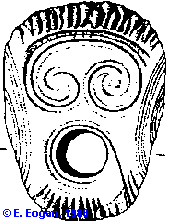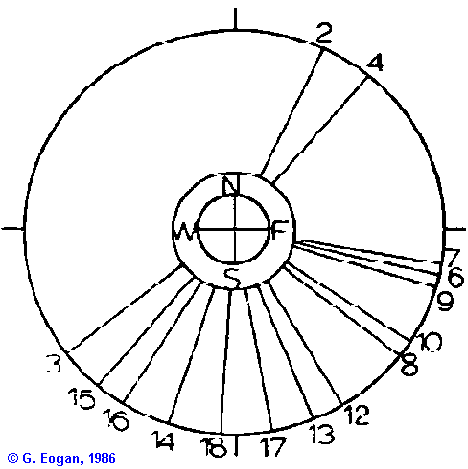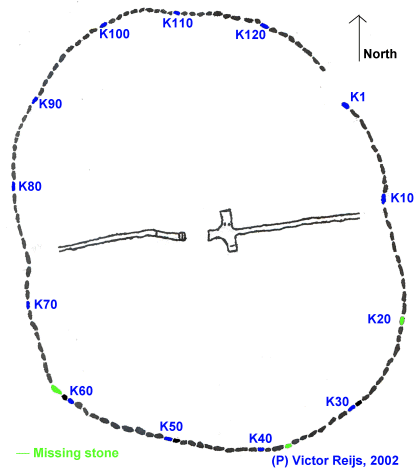 Home
Home Up
Up Search
Search Mail
Mail
NEW
Megalithic art studies by G. Eogan
Interesting issues
Only a few places in Ireland still show the megalithic art on the rocks
in passage mounds/cairns. It could be that some passage mounds/cairns
have
no petroglyphs (e.g. due to bad rock: like limestone or granite), but
had
other means of depicting art, like pictographs with paint on rock,
textile
or skin. These pictographs would not have survived the damp Irish
climate.
The methods for making petroglyphs were a) picking/pocking (line
picking
or pick dressing) and b) incision (less used).
Pick dressing seems only to be found in the Boyne Valley. Pick dressing
is sometimes used to obliterate earlier motifs. Stratigraphy of motifs
is also used. Incision was sometimes used to guide the line picking.
At Knowth the amount of invisible art seems much smaller than at
Newgrange.
Motifs
Several classification schemes of motifs are available:
- ten motifs (C.
O'Kelly)
Subdivided in curvilinear (circles, spirals, arcs, serpentiforms,
dot-in-circles
and radials) and rectilinear (zigzags, lozenges/triangles, offsets and
parallel lines). - eleven motifs (E.S. Twohig)
Uses comparable motifs as C.O'Kelly,
but added cup marks - thirteen motifs (S. Piggott)
- fifteen motifs (M. Herity)
Styles
G. Eogan [1986] defines fifteen styles
(compositions
of motifs) on decorated surfaces:
- Angular
lozenges/triangles, zigzags - Angular-spiral
Spiral is prominent, but lozenges/triangles are a feature - Rectilinear
Concentric or boxed rectangular are main characteristics - Large
nested arcs
- Serpentiforms
- Spirals
- Circular
- Dispersed circles
- Prominent central motif
- Opposed C's (arcs)
- Lavish
An all-over ornament of different types (mainly curvilinear) - Linear
Parallel lines - Random
Types are dispersed in a somewhat haphazard manner - Unaccomplished
Not very well produced - Miscellaneous
Compositions
No full corpus of known Knowth art is published in G. Eogan [1986].
An overview is given of the position of megalithic art at Dowth South,
Newgrange, Knowth site 1 to site 18, Barclodiad y Gawres (Wales) and
Fourknocks
I.
The spirals on the macehead are depicted below:

Directions
Knowth has an eastern and western direction in its two passages. More
information
on real azimuth of these passages can be found on this
page.
Directions of the sites around Site1:

Origins
According to G. Eogan the origin of the megalithic art must have been
introduced
to Ireland. Almost all motifs could have some origin in European except
perhaps the spirals (although a native origin has not been
demonstrated).
But the Irish passage-tomb art as a whole clearly shows
native originality, as is seen in the polling of angular and lavish
elements
to form the angular-spiral style, or even in the disposition of motifs
in the circular style and in the style with the prominent central
motif.
External borrowing, coupled with native pooling and reorganization,
characterizes
the Irish passage-tomb art. (G. Eogan [1986,
page 171])
Chronology
The angular style is earlier than the rectilinear style.
Styles with curvilinear motifs (like lavish) were earlier than the
rectilinear style.
Although in Knowth site 1 (and Newgrange) integration exists between
various motifs over the sites and also between the styles. Knowth site
1 must be dated later neolithic (circa 3100 BCE).
Some remarks
- The north direction in figure 15 is, I assume, magnetic north (at
least
comparing it with figure 9 and my own
measurements)
- The empty spaces shown in figure 9 and 15 west of kerbstones 37
and 62
don't exist. See below for a new map (including
correct northern direction):

- Plate
77 is of kerbstone 78 instead of kerbstone 92.
Questions to author
It seems the lines C-D and A-B are at the wrong
position in
figure 15 (comparing
this with fig. 16).
Disclaimer and Copyright
 Home
Home Up
Up Search
Search Mail
Mail
Last content related changes: May 7, 2002


